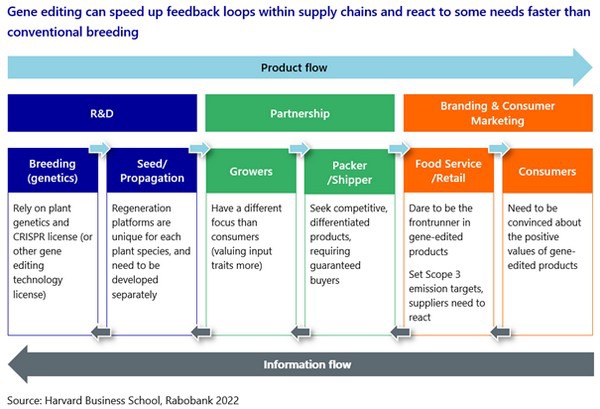Conflicting regulatory standing between the EU and the US has created a divided market for investment in gene-editing technologies in agriculture. Still, product development is moving ahead. Gene-edited products will soon be available, with specialty crops like fruit and vegetables among the first to hit supermarket shelves. A new Rabobank report details the regulatory landscape and outlines opportunities for industry players.
Gene-editing technology, especially CRISPR, offers the possibility to design a plant without introducing foreign genes, reducing some of the controversy associated with earlier genetically modified organisms (GMOs). How gene-edited products will be treated on the market depends largely on local regulations. For example, the EU, Mexico, and New Zealand classify gene-edited products as GMOs. A larger number of other countries, including the US, China, and Brazil, treat gene-edited products as conventional products but may still evaluate their market suitability based on the final product itself or how it was produced.

© Stacey Callaway | Dreamstime.com
“Treating gene-edited products as conventional products will surely have long-term impacts on the whole supply chain,” says Chia-Kai Kang, Analyst – Farm Inputs at Rabobank. “For example, in plant breeding, gene editing can shorten the breeding cycle in crops like corn from eight to ten years down to five to six years, saving R&D costs and aligning more closely with the needs of the supply chain.”
Specialty crops
Specialty crops, like fruit and vegetables, with traits that are desirable to consumers, will be among the first gene-edited products to hit the market. “When developing varieties, it is usually easier to focus on output traits rather than input traits,” Kang explains. “Input traits generally involve more genes. Output traits of crops, including flavor, color, nutrients, and shelf life, create value for consumers and retailers.” Input traits – such as drought stress tolerance, higher yields, and better nutrient use efficiency – create value for growers.
The first examples of gene-edited specialty crops with output traits include a tomato with boosted vitamin D that could soon be on UK supermarket shelves, a tomato with high levels of gamma-aminobutyric acid (GABA) in Japan, and a mushroom that won’t turn brown in the US.

Supply chain cooperation
A supply chain approach will be extremely important for successfully launching new gene-edited varieties with desirable output traits. For each new specialty product, companies will need to engage with the right partners along complex produce supply chains to develop sustainable and profitable business models. To develop better varieties, for example, breeders will need information from downstream in the supply chain – for instance, consumer preference data collected from retailers. For now, new products are likely to be developed by startups and spin-off companies from science and academia. Current big players in breeding will want to wait and see what happens first to avoid reputational risks. Successful business models will be a blueprint for other products and regions to follow.
Kang: “In the short term, we can expect output traits in specialty crops to bloom in the next five years. This could vastly impact the supply chain and production systems, and it could also influence consumers’ views of gene-edited products.”
Click here to read the report.
Chia-Kai Kang
